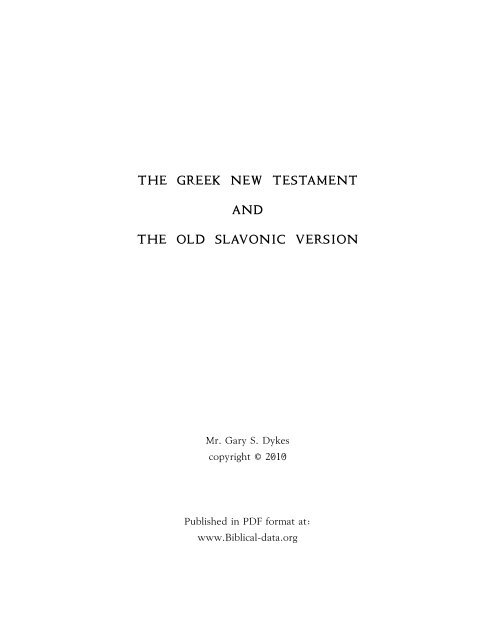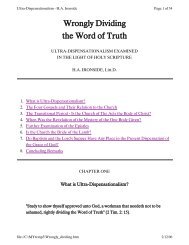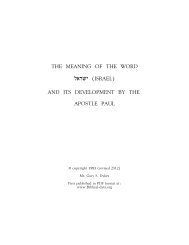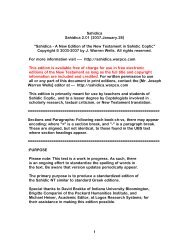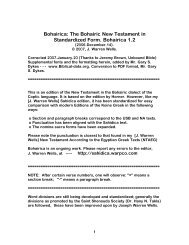OCS and the Greek New Testament - Biblical-data.org
OCS and the Greek New Testament - Biblical-data.org
OCS and the Greek New Testament - Biblical-data.org
Create successful ePaper yourself
Turn your PDF publications into a flip-book with our unique Google optimized e-Paper software.
<strong>the</strong> greek new testament<br />
<strong>and</strong><br />
<strong>the</strong> old slavonic version<br />
Mr. Gary S. Dykes<br />
copyright © 2010<br />
Published in PDF format at:<br />
www.<strong>Biblical</strong>-<strong>data</strong>.<strong>org</strong>
The Old Church Slavonic version of <strong>the</strong> <strong>New</strong> <strong>Testament</strong>, though<br />
extant remains are no earlier than circa A.D. 1000, has value for<br />
determining <strong>the</strong> early <strong>and</strong> perhaps even <strong>the</strong> earliest <strong>Greek</strong> text of <strong>the</strong><br />
<strong>New</strong> <strong>Testament</strong>. (for an example see note after <strong>the</strong> references).<br />
In my terminology, I will use <strong>the</strong> abbreviation Ú¯which<br />
being Old Church Slavonic¯for <strong>the</strong> somewhat later <strong>and</strong> more<br />
diversified Old Slavonic manuscripts. Linguistically speaking <strong>the</strong> actual<br />
Ú language is scantily seen even in <strong>the</strong> oldest surviving manuscripts<br />
(typically of <strong>the</strong> four gospels, <strong>and</strong> several o<strong>the</strong>rs [gospel-lessons,<br />
Psalters et al]). The original Old Church Slavonic quickly experienced<br />
some phonetic <strong>and</strong> morphological modifications to fit its wider<br />
environment of various speakers. Even <strong>the</strong> earliest surviving manuscripts<br />
show some adjustments towards certain forms of <strong>the</strong> various<br />
Slavic languages. These various forms have been termed recensions<br />
which term is not meant to imply an altered text as concerns its<br />
semantics or readings. These so-called recensions simply reflect <strong>the</strong><br />
various phonetic <strong>and</strong> morphological alterations conformable to each<br />
specific form of Old Slavonic in use. Typically <strong>the</strong> forms are:<br />
Bulgarian (Bulgarian-form)<br />
Serbian (Serbian-form)<br />
Croatian (Croatian-form)<br />
Macedonian (Macedonian-form)<br />
Old Russian (Russian-form)<br />
In each of <strong>the</strong>se forms of Old Slavonic, experts can detect <strong>the</strong><br />
subtle morphological changes which suggest which of <strong>the</strong> above classes
of language are utilized. Even laymen can make some of <strong>the</strong>se<br />
observations, when <strong>the</strong> basic paradigm forms are known <strong>and</strong> compared.<br />
However Mathiesen [Mathiesen - 483ff] cautions against using<br />
statistics generated from simple frequency counts of occurrences of<br />
forms. Mathiesen does use statistics, but in a more refined fashion.<br />
Simple frequency counts are not always dependable because:<br />
(1) A scribe may use a differing form because that is what is<br />
seen in his/her exemplar.<br />
(2) A scribe may vary from <strong>the</strong> hypo<strong>the</strong>sized norm, for <strong>the</strong><br />
sake of variety, or use one from memory.<br />
(3) A scribe's type of Ú is not always determined by his/her<br />
own vernacular. Cases exist (according to Mathiesen) in which<br />
a scribe uses a form o<strong>the</strong>r than his/her own vernacular.<br />
(4) Per <strong>the</strong> studies formulated by R. Jakobson, certain phonetic<br />
forms may change (exhibited in altered morphology) via a<br />
changing phonological environment. Combinations of sounds<br />
induce some changes; continuant paired with grave [note,<br />
Arlotto - 222f., also Lunt - 33] et al. Thus frequency counts<br />
alone, do not take into account <strong>the</strong>se minor fluctuations due to<br />
evolving phonetic expansions <strong>and</strong> contractions as <strong>the</strong> text is<br />
implemented into ano<strong>the</strong>r Slavic form (Serbian, Russian et<br />
cetera). These changes which are often predictable, never<strong>the</strong>less,<br />
are somewhat r<strong>and</strong>om <strong>and</strong> inconsistent as <strong>the</strong> grammars<br />
had not <strong>the</strong>n been fully codified.<br />
Thus, when one observes some occasional forms which suggest<br />
a Serbian-form (note: I prefer to use "Serbian-form" instead of<br />
"Serbian recension") one must not be quick to identify <strong>the</strong> language of
<strong>the</strong> manuscript as a Serbian-form of <strong>the</strong> Ú. Never<strong>the</strong>less, such<br />
observations can contribute to <strong>the</strong> overall analysis of just what form is<br />
used. Ornamentation styles, calendars, formats, religious biases,<br />
provenance, textual comparisons, colophons <strong>and</strong> many o<strong>the</strong>r features<br />
can all contribute to ascertaining <strong>the</strong> type of Ú employed.<br />
For example we might observe <strong>the</strong> simple reflexive pronoun: s0<br />
(<strong>the</strong> vowel -0 is pronounced like <strong>the</strong> in in "sin"). It serves as a<br />
reflexive pronoun, it can also turn an active verb into a passive, <strong>and</strong> a<br />
transitive verb into an intransitive [Schmalstieg - 281].<br />
<strong>the</strong> Ú form is: - s0 (for <strong>the</strong> accusative)<br />
<strong>the</strong> Serbian form is: - se<br />
<strong>the</strong> Russian form is: - q$ (-qa or -q$ both verbal suffixes, <strong>and</strong><br />
both are enclitic forms of <strong>the</strong> pronoun qeaþ or qeae)<br />
<strong>the</strong> Old Bulgarian is: - s0<br />
Many o<strong>the</strong>r variations can be displayed (such as <strong>the</strong> "jers") but<br />
such displays are beyond <strong>the</strong> scope of this introduction. But do note:<br />
in <strong>the</strong> above, <strong>the</strong> Russian pronoun is usually affixed to a verb, as one<br />
word, when this habit is observed, one may can surmise that a<br />
Russian oriented scribe is at work, or <strong>the</strong> language is mixed Old Russian<br />
<strong>and</strong> o<strong>the</strong>r Slavic.<br />
Simplifying <strong>the</strong> task of working with Ú texts is <strong>the</strong> fact that<br />
<strong>the</strong> Ú grammar coincides quite nicely with <strong>Greek</strong>. [Lunt in Metzger<br />
- 437f.]. It is not difficult to move from one language to ano<strong>the</strong>r. Ú<br />
may in some respects be easier to master than <strong>Greek</strong>, as for example<br />
every stem of every declinable word ends in a consonant!
There are about seven existing true Ú manuscripts, none of<br />
<strong>the</strong>m contain <strong>the</strong> Pauline epistles. The earliest known Old Slavic<br />
manuscript containing some or all of <strong>the</strong> Pauline epistles is <strong>the</strong><br />
Christinopolitian, it is dated at circa XII th , (per Kavuzniacki) <strong>and</strong> is of<br />
<strong>the</strong> Serbian-form. In Metzger's work (probably by Lunt) it is dated<br />
circa XI th . When we note <strong>the</strong> surviving manuscripts from <strong>the</strong> XI th<br />
century to <strong>the</strong> invention of printing, thous<strong>and</strong>s are found! (most now<br />
reside in Russia).<br />
Thus for <strong>the</strong> Pauline corpus, <strong>the</strong> earliest surviving manuscripts<br />
are about 200 or more years later than <strong>the</strong> work of Methodius <strong>and</strong><br />
Constantine (a.k.a. Cyril). Yet since <strong>the</strong> manuscripts, invariably, maintain<br />
a very literal relationship with <strong>the</strong>ir <strong>Greek</strong> exemplars¯we have on<br />
an a priori basis¯accurate copies of <strong>the</strong> IX th century creations.<br />
Despite <strong>the</strong> strong possibility that we have later, yet accurate<br />
copies; numerous scholars have reckoned <strong>the</strong> value of <strong>the</strong> Ú manuscripts<br />
as practically useless for clarifying <strong>the</strong> original <strong>Greek</strong>, <strong>and</strong> for<br />
establishing <strong>the</strong> earliest <strong>and</strong> best original <strong>Greek</strong> text. This overt error<br />
of omission has somewhat purloined <strong>the</strong> productive studies of <strong>the</strong>se<br />
Old Slavic texts as concerns <strong>the</strong>ir relationships with <strong>the</strong> <strong>Greek</strong> <strong>New</strong><br />
<strong>Testament</strong> manuscript tradition. One of <strong>the</strong> influential lobbyist's for<br />
<strong>the</strong> exclusion of healthy Ú studies has been <strong>the</strong> late Dr. Bruce<br />
Manning Metzger. Note this quote from one of his popular works:<br />
...it goes without saying that this version, originating as it did in <strong>the</strong> ninth<br />
century, has little or no significance so far as an attempt to ascertain <strong>the</strong><br />
original text is concerned. [Metzger - 430]<br />
The late Horace G. Lunt also slights <strong>the</strong> potential impact of <strong>the</strong><br />
Ú documents on page 441 in Metzger above. However Lunt does so<br />
by declaring that since its inception <strong>the</strong> Ú testimony has undergone<br />
constant revision, to accord with <strong>the</strong> "local <strong>Greek</strong> authority". Lunt has<br />
indeed examined some manuscripts, especially those of <strong>the</strong> Gospels,<br />
but research has yet to be done on <strong>the</strong> Pauline epistles, thus his<br />
remarks as concerns <strong>the</strong> Pauline corpus appears somewhat premature.
In <strong>the</strong> 1954 publication by <strong>the</strong> great versional scholar, Vööbus,<br />
Early Versions of <strong>the</strong> <strong>New</strong> <strong>Testament</strong>, absolutely no mention is made of<br />
<strong>the</strong> Ú. In volume I, of Institutiones Biblicae: Scholis Accomo<strong>data</strong>e, 6th<br />
edition, published in Rome in 1951, only three paragraphs in its 584<br />
pages mentions <strong>the</strong> Ú.<br />
In a 1995 publication, giving <strong>the</strong> Status Quaestionis, or an<br />
overview of <strong>the</strong> present state of <strong>New</strong> <strong>Testament</strong> research, [E <strong>and</strong> H]<br />
<strong>the</strong> Ú version is not even mentioned! Though <strong>the</strong> Ge<strong>org</strong>ian <strong>and</strong><br />
Armenian are¯even Old Norse <strong>and</strong> Old Saxon are mentioned¯but not<br />
<strong>the</strong> Ú! The first modern <strong>Greek</strong> <strong>New</strong> <strong>Testament</strong> to give some<br />
references to Slavic readings, is <strong>the</strong> UBSGNT 4 [s.v. UBSGNT in<br />
references]. However it is a very basic implementation.<br />
For example at I Corinthians 1:13, <strong>the</strong> UBSGNT 4 indicates <strong>the</strong><br />
Slavic as supporting <strong>the</strong> omission of <strong>the</strong> <strong>Greek</strong> negative mh. In doing<br />
so <strong>the</strong>y would be relying on <strong>the</strong> Sisatovac Apostoloi, or <strong>the</strong><br />
Christinopolitan, [s.v. <strong>the</strong>ir list of sources UBSGNT 4 - 28*]. They<br />
indicate that both manuscripts omit <strong>the</strong> negative. They are wrong on<br />
both counts:<br />
Christinopolitan reads: Rda ra9dYlI....<br />
Sisatovac reads: Jda ra9dYlI....<br />
They both have, "Has Christ been divided?".<br />
In both cases, <strong>the</strong> negative is clearly seen - Rda. This particular<br />
negative represents <strong>the</strong> question forming aspect of <strong>the</strong> <strong>Greek</strong> negative<br />
mh very well.
In ano<strong>the</strong>r example from <strong>the</strong> UBSGNT 4 , at I Corinthians 7:5,<br />
<strong>the</strong> apparatus indicates that both of <strong>the</strong>ir Slavic witnesses contain <strong>the</strong><br />
word for "fasting", when in reality, <strong>the</strong> Sisatovac omits <strong>the</strong> word.<br />
Generally speaking <strong>the</strong> UBSGNT is relatively accurate as far as it<br />
goes, it does not mention numerous o<strong>the</strong>r variations or Byzantine<br />
alignments. Many of <strong>the</strong> versional variants indicated in <strong>the</strong> edition<br />
show <strong>the</strong> various forms of <strong>the</strong> name "Jesus Christ", or "Christ Jesus"<br />
or "our Lord Jesus Christ", which variations are easy to spot in most<br />
any version of <strong>the</strong> <strong>New</strong> <strong>Testament</strong>¯<strong>the</strong>y also do not add to our grasp<br />
of <strong>the</strong> meaning of <strong>the</strong> <strong>Biblical</strong> text. Certainly experts Slavists can<br />
greatly improve <strong>the</strong> apparatus of <strong>the</strong> UBSGNT editions <strong>and</strong> indicate<br />
<strong>the</strong> individual Slavic readings on a manuscript by manuscript basis,<br />
<strong>and</strong> not grouping several manuscripts under one term or siglum.<br />
In my opinion <strong>the</strong> Ú manuscripts of <strong>the</strong> Pauline epistles, are<br />
valuable <strong>and</strong> can be properly used to divine <strong>the</strong> <strong>Greek</strong> wording used<br />
in its (<strong>the</strong>ir) original inception. If this is true, <strong>the</strong>n we can by just<br />
using several Ú manuscripts reconstruct <strong>the</strong> underlying <strong>Greek</strong><br />
original. Here I remind <strong>the</strong> reader that <strong>the</strong> Ú translations are very<br />
literal, following very closely <strong>the</strong> underlying <strong>Greek</strong> semantics <strong>and</strong><br />
structure. Most importantly, is <strong>the</strong> probability that this <strong>Greek</strong> original<br />
is itself an old Byzantine manuscript. Who knows how far back <strong>the</strong><br />
Ú testimony can reach? perhaps as early as <strong>the</strong> 2 nd century! This is<br />
possible, <strong>and</strong> remains yet to be validated (as to which century <strong>the</strong><br />
MSS reach back to). One must recall that many of <strong>the</strong> earliest manuscripts<br />
in most Slavic regions have been destroyed; a sad reminder of<br />
<strong>the</strong> turbulent history of <strong>the</strong> Balkans. Assuredly Constantine <strong>and</strong><br />
Methodius used a reliable <strong>Greek</strong> manuscript, <strong>and</strong> in A.D. 860 it is<br />
certain that very old Byzantine manuscripts still existed in<br />
Constantinople <strong>and</strong> elsewhere. As long as this is possible, why ignore<br />
<strong>the</strong> evidence? I suspect it is because of <strong>the</strong> bias generated by those<br />
who prefer <strong>the</strong> Egyptian recension, by those who wish to move<br />
beyond <strong>the</strong> powerful Byzantine text-type!
In Romans 15:19 we read:<br />
in <strong>the</strong> power of signs <strong>and</strong> wonders, in <strong>the</strong> power of <strong>the</strong> Holy Spirit; so that<br />
from Jerusalem, <strong>and</strong> round about even unto Illyricum, I have fully preached<br />
<strong>the</strong> gospel of Christ;<br />
[per <strong>the</strong> 1751 Elizabethan <strong>New</strong> <strong>Testament</strong>, Russian-form]<br />
As mentioned in <strong>the</strong> above <strong>and</strong> in a few o<strong>the</strong>r <strong>New</strong> <strong>Testament</strong><br />
passages, Paul did preach to those in Macedonia, <strong>and</strong> probably into<br />
what is now Albania. How far did he penetrate? Well, that depends<br />
upon <strong>the</strong> prepositions herein <strong>and</strong> below, ("unto Illyricum" - <strong>Greek</strong><br />
mecri which means "as far as"). Now Illyricum spans <strong>the</strong> nor<strong>the</strong>rn<br />
coastal area of <strong>the</strong> eastern seaboard of <strong>the</strong> Adriatic Sea. This would be<br />
modern Croatia! Did Paul venture into <strong>the</strong>se mountains of Illyricum?<br />
If not, he certainly was in sight of <strong>the</strong>m. Giving us a bit more <strong>data</strong><br />
would be Acts 19:21, 22 <strong>and</strong> 20:1-3:<br />
Now after <strong>the</strong>se things were ended, Paul purposed in <strong>the</strong> spirit, when he<br />
had passed through Macedonia <strong>and</strong> Achaia, to go to Jerusalem, saying,<br />
After I have been <strong>the</strong>re, I must also see Rome. (22) And having sent into<br />
Macedonia two of <strong>the</strong>m that ministered unto him, Timothy <strong>and</strong> Erastus, he<br />
himself stayed in Asia for a while. [Acts 19:21, 22]<br />
And after <strong>the</strong> uproar ceased, Paul having sent for <strong>the</strong> disciples <strong>and</strong> exhorted<br />
<strong>the</strong>m, took leave of <strong>the</strong>m, <strong>and</strong> departed to go into Macedonia. (2) And<br />
when he had gone through those parts, <strong>and</strong> had given <strong>the</strong>m much<br />
exhortation, he came into Greece. (3) And when he had spent three<br />
months <strong>the</strong>re, <strong>and</strong> a plot was laid against him by Jews as he was about to<br />
set sail for Syria, he determined to return through Macedonia.<br />
[Acts 20:1-3]
We now see <strong>the</strong> prepositions for "through" as <strong>the</strong> <strong>Greek</strong> eij<br />
from which we can state that "into" or "through" would be<br />
appropriate¯as well as "to" or "unto" grammatically speaking¯on <strong>the</strong><br />
basis of <strong>the</strong> Romans passage [Harnack - 92]. (Incidentally, <strong>the</strong> Slavic<br />
preposition do in <strong>the</strong> Romans text, means "to", or "as far as" a literal<br />
representation of <strong>the</strong> <strong>Greek</strong> mecri).<br />
In all probability, in about A.D. 56-57 Paul preached to <strong>the</strong><br />
peoples of <strong>the</strong> region of Illyricum (or modern Albania). Paul certainly<br />
had translators with him, <strong>and</strong> <strong>the</strong> language he most likely encountered<br />
in A.D. 57 was Macedonian <strong>Greek</strong> probably up unto <strong>the</strong> Albanian<br />
Alps, <strong>and</strong> <strong>the</strong>n northward he may have encountered <strong>the</strong> <strong>the</strong> now<br />
extinct Illyrian language (related to Messapic <strong>and</strong> Venetic <strong>and</strong> perhaps<br />
also Rhaetic) from which modern Albanian evolved.<br />
Whatever impact Paul, <strong>the</strong> Apostle to <strong>the</strong> nations, had some<br />
810 years before Constantine <strong>and</strong> Methodius, may be lost to history.<br />
For shortly <strong>the</strong>reafter <strong>the</strong> Latin missionaries¯from <strong>the</strong> Roman<br />
occupations <strong>and</strong> from <strong>the</strong> nor<strong>the</strong>rn Germanic folks¯swept away <strong>the</strong><br />
pure unadulterated truths which <strong>the</strong> Apostle Paul had espoused.<br />
Adolf Harnack has done a fine job of collecting references to churches<br />
<strong>and</strong> Christian centers in <strong>the</strong> first 4oo years or so after Jesus Christ.<br />
Below is an extract from one of his works:
[Harnack - 236ff]<br />
Perhaps some of Paul's distinctive teachings left a permanent<br />
mark upon <strong>the</strong> early history of <strong>the</strong> Balkans. However, as <strong>the</strong> following<br />
map illustrates, waves of various conquerors <strong>and</strong> immigrants radically<br />
altered <strong>the</strong> human l<strong>and</strong>scape of <strong>the</strong> Balkans. It is well known that <strong>the</strong><br />
Huns destroyed many religious centers, completely. The Turks showed<br />
no less mercy. Most ancient monasteries were destroyed, in fact to my<br />
knowledge, none of <strong>the</strong> pre-tenth century monasteries remain.<br />
Even as late as <strong>the</strong> Serbian-Croatian war in <strong>the</strong> 1990s, <strong>Biblical</strong><br />
manuscripts were lost, add to this <strong>the</strong> number lost during WWII<br />
(especially in Macedonia <strong>and</strong> Russia) <strong>and</strong> <strong>the</strong> numbers are<br />
considerable. Though <strong>the</strong> Magyar invasion in <strong>the</strong> 10 th century stopped<br />
<strong>the</strong> future gains of <strong>the</strong> labors of Constantine <strong>and</strong> Methodius,<br />
subsequent wars have fur<strong>the</strong>r reduced <strong>the</strong> number of <strong>the</strong> written<br />
remains of <strong>the</strong> earliest Ú manuscripts.<br />
Despite <strong>the</strong> losses, our all-powerful God has preserved a few<br />
later manuscripts; manuscripts which retain a sound copy of <strong>the</strong><br />
earlier works. In His Providence little or nothing has been lost!
Map borrowed from: Life World Library, The Balkans. Copyright ©<br />
1964, by Time Inc.. page 27. (Image has had some minor digital<br />
alterations).
The surviving Ú manuscripts (or later Slavonic) today<br />
number in <strong>the</strong> thous<strong>and</strong>s. Very little research has been accomplished<br />
concerning <strong>the</strong>m. I myself, am presently working with five Ú<br />
manuscripts of <strong>the</strong> Apostoloi. In my preliminary findings, I have<br />
noticed a fairly uniform text. Normally this suggests some common<br />
source. True. Yet one must also recall that <strong>the</strong> <strong>Greek</strong> Byzantine texttype<br />
itself is remarkably homogeneous. The real work is recognizing<br />
<strong>the</strong> earlier strata of readings surviving in <strong>the</strong> Ú texts. Workers who<br />
have a good grasp of <strong>the</strong> full diachronic aspects of <strong>the</strong> Byzantine texttype<br />
can see behind <strong>the</strong> Ú readings <strong>and</strong> see <strong>the</strong> remnants of <strong>the</strong><br />
very early Byzantine text-type, perhaps as early as <strong>the</strong> 3rd or 4th centuries. Never<strong>the</strong>less, we have preserved for us today fine copies of<br />
<strong>the</strong> old Slavic version, a clear window to <strong>the</strong> text of <strong>the</strong> 9th century<br />
<strong>and</strong> earlier. It is probable too, that <strong>the</strong> underlying <strong>Greek</strong>, would<br />
illuminate that <strong>Greek</strong> “ form ” (dialect) as it was in Antioch <strong>and</strong><br />
environs just prior to <strong>the</strong> work of <strong>the</strong> great missionaries.<br />
Henry Cooper's observation [Cooper - 27] that no homogeneity<br />
is seen amongst <strong>the</strong> Gospel Ú manuscripts, may be due to his<br />
dwelling upon <strong>the</strong> differences due to <strong>the</strong> forms of <strong>the</strong> Slavic texts<br />
(Serbian-form, Russian-form, et al), one probably should not apply<br />
his view to <strong>the</strong> Apostoloi texts. There is much research which remains.<br />
One example of some current research is that by Johannes G.<br />
van der Tak. He has collated numerous Apostolus manuscripts,<br />
specifically comparing <strong>the</strong> text of a selection of pericopes. The<br />
variations which he reveals seem somewhat minor, in contrast to <strong>the</strong><br />
great deal of agreement between <strong>the</strong> commented texts <strong>and</strong> lectionaries<br />
which he uses. He groups <strong>the</strong> manuscripts into several categories,<br />
based upon <strong>the</strong>ir formats (Lectionary, Continuous or Commented).<br />
He confirms that numerous synonyms are employed <strong>and</strong> that several<br />
"redactions" seem to exist. He also confirms that <strong>the</strong> underlying <strong>Greek</strong><br />
text is <strong>the</strong> Byzantine text-type. He would also caution against<br />
premature grouping of manuscripts, as more <strong>data</strong> is needed. In all he<br />
examines parts of 19 Old Slavic manuscripts, <strong>and</strong> if anything, reveals
<strong>the</strong> close relationship which all of <strong>the</strong> manuscripts have. Because he<br />
focuses on <strong>the</strong> variations, he often misses <strong>the</strong> vast uniformity.<br />
Finally, it is worthwhile to recall that <strong>the</strong> Old Latin manuscripts<br />
did also reflect a literal translation technique, <strong>and</strong> followed <strong>the</strong> <strong>Greek</strong><br />
original closely. They are grouped via observation of <strong>the</strong> use of various<br />
synonyms <strong>and</strong> o<strong>the</strong>r minor rendering variations. It is my observation<br />
that <strong>the</strong> Ú Apostoloi manuscripts (lectionaries <strong>and</strong> full texts) are<br />
also very uniform, most likely reflecting a single much older text-type.<br />
When Constantinople severed itself from <strong>the</strong> Pope in Rome,<br />
territories were divided. The line of division passed through Serbia.<br />
The Western element represented by <strong>the</strong> Latin Church of Rome, <strong>the</strong><br />
Eastern element represented by <strong>the</strong> Byzantine Church in Constantinople.<br />
The division divided <strong>the</strong> peoples of <strong>the</strong> South Slavic territories<br />
as well as <strong>the</strong> physical boundaries. East/West antagonisms are still felt<br />
today. But we should be thankful that much of Bulgaria <strong>and</strong> Serbia<br />
remained steadfastly Orthodox. Because of <strong>the</strong> steadfastness of <strong>the</strong><br />
South Slavic peoples¯in <strong>the</strong>ir devotion to translation of <strong>the</strong> <strong>Greek</strong><br />
Scriptures, to writing <strong>and</strong> because of <strong>the</strong>ir devotion to learning¯<strong>the</strong><br />
gospel <strong>and</strong> Byzantine learning passed on to Russia, along with <strong>the</strong><br />
Cyrillic alphabet. Russia, in <strong>the</strong> mid-900s, began to move out of <strong>the</strong><br />
darkness of paganism! So now, for centuries via <strong>the</strong> Russian Synodal<br />
Bible, <strong>the</strong> Byzantine text-type influenced <strong>and</strong> influences millions of<br />
Slavs. This is not some accident of mere chance!
eferences<br />
Mathiesen, Robert. "The Determination of Norms (A Problem in <strong>the</strong> Diachronic<br />
Study of Church Slavonic)". American Contributions To The Eighth<br />
International Congress of Slavists. Vol. I, Linguistics <strong>and</strong> Poetics. Ed. Henrik<br />
Birnbaum. 1978. Slavica Publishers. Columbus, Ohio.<br />
Arlotto, Anthony. Introduction to Historical Linguistics. 1972. Houghton Mifflin Co..<br />
Lunt, Horace G.. Old Church Slavonic Grammar. 6th ed.. 1974. Mouton & Co..<br />
Schmalstieg, William, R.. An Introduction to Old Church Slavonic. 2 d ed.. Slavica<br />
Publishers. 1983.<br />
Lunt, Horace G.. "Limitations of Old Church Slavonic in Representing <strong>Greek</strong>". The<br />
Early Versions of The <strong>New</strong> <strong>Testament</strong>. Bruce Manning Metzger. 1977.<br />
Clarendon Press, Oxford. [Lunt in Metzger]<br />
Kavuzniacki, Aemilianus. Actus Epistolaeque Apostolorum Palaeoslovenice. Ad Fidem<br />
Codicis Christinopolitani. 1846. Caroli Geroldi Filium. Vienna.<br />
Metzger, Bruce M.. The Early Versions of The <strong>New</strong> <strong>Testament</strong>. 1977. Clarendon Press,<br />
Oxford.<br />
[E <strong>and</strong> H] - Ehrman, Bart D. <strong>and</strong> Holmes, Michael W.. editors. The Text of <strong>the</strong> <strong>New</strong><br />
<strong>Testament</strong> in Contemporary Research: Essays on <strong>the</strong> Status Quaestionis. Studies<br />
<strong>and</strong> Documents, vol. 46. 1995. William B. Eerdmans. Michigan<br />
UBSGNT - The <strong>Greek</strong> <strong>New</strong> <strong>Testament</strong>, Fourth Revised Edition. editors: Barbara Al<strong>and</strong>,<br />
Kurt Al<strong>and</strong>, Johannes Karavidopoulos, Carlo M. Martini <strong>and</strong> Bruce Manning<br />
Metzger. 1993. United Bible Societies.<br />
Miklosich, Franz. Apostolus, E Codice Monasterii ÎiÎatovac, Palaeo-Slovenice. 1853.<br />
Guilelmum Bramüller. Vienna.<br />
Harnack, Adolf. The Mission <strong>and</strong> Expansion of Christianity in <strong>the</strong> First Three Centuries.<br />
James Moffatt (trans.) 2 d ed.. Vol. II. 1908. G. P. Putnam's Sons. <strong>New</strong> York<br />
<strong>and</strong> London - Williams <strong>and</strong> N<strong>org</strong>ate.
Cooper, Henry, R.. Slavic Scriptures: The Formation of <strong>the</strong> Church Slavonic Version of<br />
<strong>the</strong> Bible. 2003. Madison, Teaneck. Fairleigh Dickinson University Press.<br />
London: Associated University Presses.<br />
van der Tak, Johannes G.. "The Apostolus Christinopolitanus <strong>and</strong> <strong>the</strong> Text of <strong>the</strong><br />
Old Slavic Apostolus; The Lessons for Saturday <strong>and</strong> Sunday of Weeks 10-20<br />
After Pentecost". polata kvníIgopIsCnaj. khô - l¤, 1996: 4-49. (English<br />
translation, available on-line, Google search term - "Christinopolitanus").<br />
___________________________<br />
NOTE<br />
An example would be <strong>the</strong> reading of "Christ" at II Thessalonians 2:2. Most <strong>Greek</strong><br />
Byzantine manuscripts read "Christ". However it is an early error. The original<br />
reading is "Lord" (day of <strong>the</strong> Lord). A few Byzantine <strong>Greek</strong> MSS retain "Lord".<br />
The <strong>OCS</strong> MSS all read "Christ". This suggests that at <strong>the</strong> date of circa A.D. 850<br />
during <strong>the</strong> work of Cyril <strong>and</strong> Methodius, some Byzantine scribes had already<br />
copied <strong>and</strong> recopied <strong>the</strong> corruption. Thus, we can conjecture that <strong>the</strong> corruption is<br />
early, pre-850 (Slavic translation date), <strong>and</strong> post-400 as <strong>the</strong> Syriac MSS read<br />
"Lord". (The Syriac version also utilized early Byzantine MSS). Thus I propose that<br />
possibly <strong>the</strong> corruption be dated as between A.D. 400 <strong>and</strong> A.D. 800. This is <strong>the</strong><br />
range wherein <strong>the</strong> corruption entered <strong>the</strong> stream of Byzantine manuscipt<br />
productions. At least this view has some historical validity. The Slavic MSS do assist<br />
with dating, <strong>and</strong> with corroborating early readings of <strong>the</strong> <strong>Biblical</strong> manuscripts.


